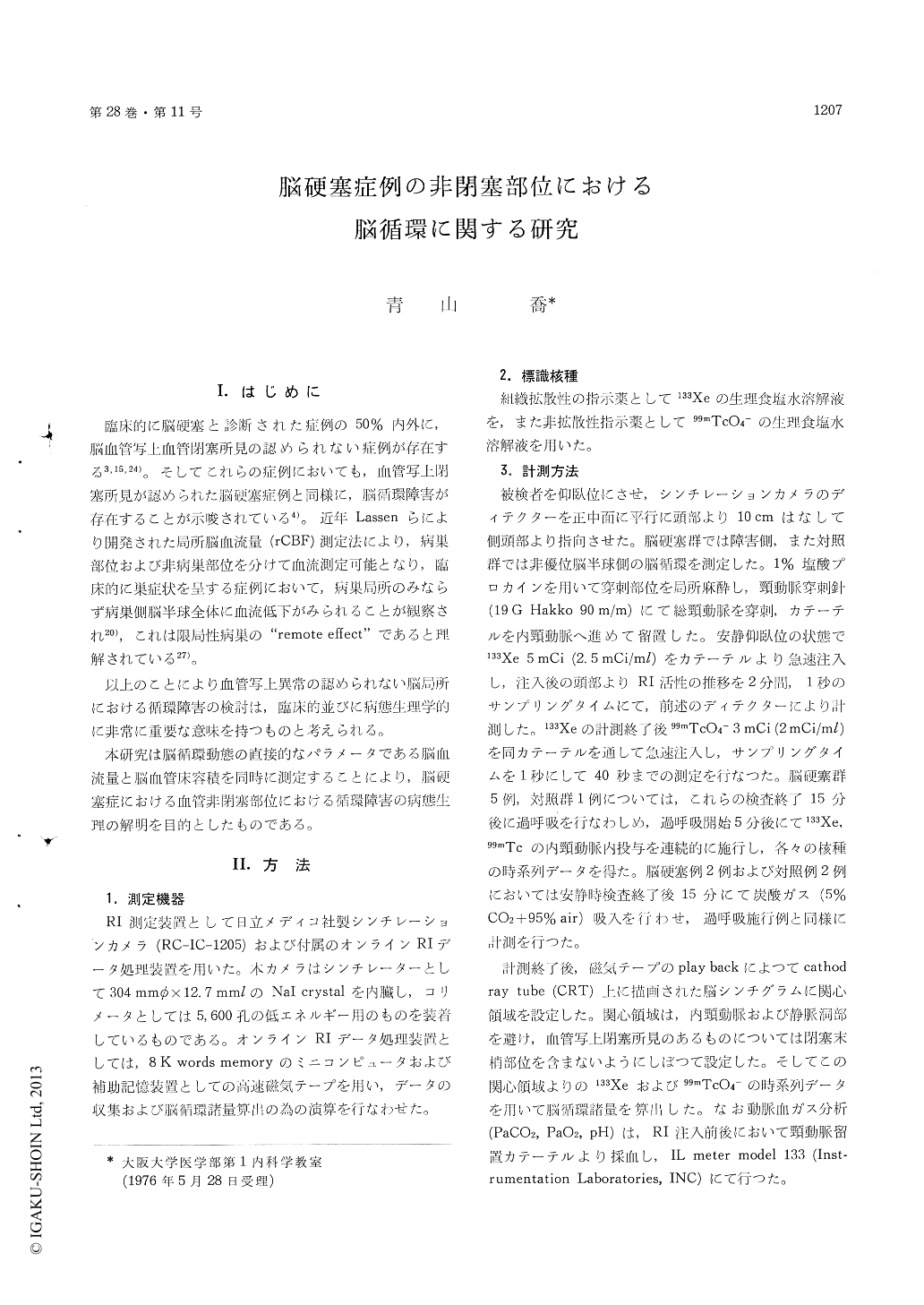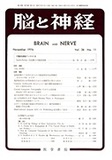Japanese
English
- 有料閲覧
- Abstract 文献概要
- 1ページ目 Look Inside
I.はじめに
臨床的に脳硬塞と診断された症例の50%内外に,脳血管写上血管閉塞所見の認められない症例が存在する3,15,24)。そしてこれらの症例においても,血管写上閉塞所見が認められた脳硬塞症例と同様に,脳循環障害が存在することが示唆されている4)。近年Lassenらにより開発された局所脳血流量(rCBF)測定法により,病巣部位および非病巣部位を分けて血流測定可能となり,臨床的に巣症状を呈する症例において,病巣局所のみならず病巣側脳半球全体に血流低下がみられることが観察され20),これは限局性病巣の"remote effect"であると理解されている27)。
以上のことにより血管写上異常の認められない脳局所における循環障害の検討は,臨床的並びに病態生理学的に非常に重要な意味を持つものと考えられる。
本研究は脳循環動態の直接的なパラメータである脳血流量と脳血管床容積を同時に測定することにより,脳硬塞症における血管非閉塞部位における循環障害の病態生理の解明を目的としたものである。
Von Monakow, in 1914, first described from clinical observations that following localized injury to the brain, temporary depression of function might occur in remote areas of the nervous system. The mechanisms of this "remote effect" have not been fully clarified.
The present study was designed to resolve the pathophysiological problems of the regional cerebral hemodynamic disorders in the areas without arterial occlusion in patients with cerebral infarction.
Twenty-six patients were studied. The patients were devided into two growps. One group of 14 patiens with cerebral infarction was examined twenty days or more after the onset. The second group (controle) consisted of the patients with miscellaneous diseases without intracranial organic lesion.
The gamma-ray scintillation camera and online radioisotope (RI) data processing system were used to detect and analyse the RI dilution curves from the examined hemisphere. 133Xe as a diffusible indicator was injected into the internal carotid artery, followed by injection of 99mTc as a non-diffusible indicator. In the cases of cerebral infarction, the RI dilution curves were derived from the angiographically non-occluded lesion of the hemisphere. The calculations of cerebral hemodynamic parameters were made as follows: Cerebral blood flow (CBF) was determined by initial slope analysis as CBF initial. Brain mean transit time (t)=(areaunder the 99mTc clearance curve)/(maximum height of 99mTc clearance curve). Cerebral blood volume (CBV)=CBF initial×t. Cerebral vascular resistance (CVR)=mean arterial blood pressure (MABP)/CBF initial.
After the examination of cerebral circulation at natural ventilation, several patients were studied at hypocapnic or hypercapnic condition.
The mean value of CBF initial in patients with cerebral infarction was 36.2±8.6 ml/100 g/min. This value was significantly low in comparison with those of control (58.5±7.0 ml/100 g/min). The significant low value of CBF initial in cases with cerebral infarction indicated the existence of cerebral circulatory disorders in the remote area of the brain. When the other cerebral hemodynamic parameters in patients with cerebral infarction were compared with those of control, t was significantly prolonged, CBV was significantly small, CVR and MABP were significantly high. The interrelationship between CBV and CVR in patients with cerebral infarction was characteristic as expressed in the equation CVR=11.72×CBV-1.037, while that of control subjects was CVR=3.36×CBV-0.498. CBV is an important factor to regulate the cerebral circulation. The clinical measurement of CBV had been difficult and a few reports had been available even in the animal study. In the present study, CBV value was revealed in the clinical cases. As the cerebral circulation might be affected by systemic blood pressure and PaCO2, changes of CBV should be discussed with the concept of CVR which was a function of blood pressure and PaCO2. The interrelationship between CBV and CVR in patients with cerebral infarction was independent to that of control. Futhermore, these interrelationships were kept in accordance with changes of arterial CO2 tension. These evidences indicate that the hypoperfusion in the remote area of cerebral infarction may not be caused by decrease of CBV, but may be mainly influenced by the other hemorheological factors.

Copyright © 1976, Igaku-Shoin Ltd. All rights reserved.


